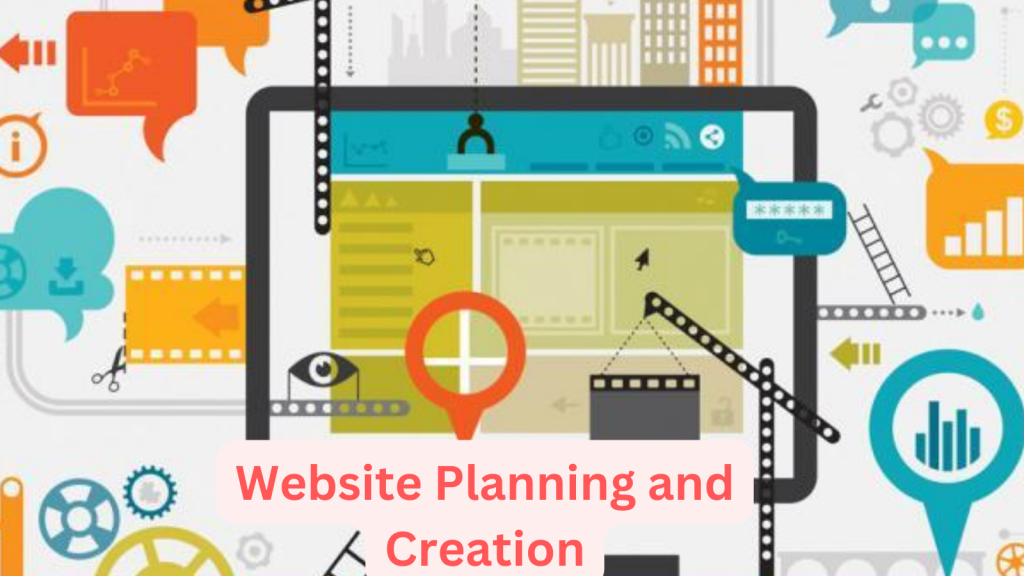
Table of Contents
Business Purpose of Creating A Website
Website planning and creation involves the process of conceptualizing, designing, and building a website. It encompasses various stages such as defining the website’s purpose, identifying the target audience, creating a site map and wireframes, designing the user interface, developing the website using programming languages such as HTML, CSS, and JavaScript, and finally, launching and maintaining the website. This process also includes considerations for user experience, search engine optimization, and overall functionality to ensure that the website meets its objectives and provides a positive experience for its visitors.
Definition
Website planning and creation is the systematic process of conceptualizing, designing, and building a website. It involves defining the website’s purpose, identifying the target audience, creating a site map and wireframes, designing the user interface, developing the website using programming languages, and launching and maintaining the website to ensure it meets its objectives and provides a positive user experience.
Process
The process of website planning and creation typically involves the following key steps:
1. Define the Purpose and Goals: Clearly outline the purpose of the website and establish specific goals that the website should achieve.
2. Identify the Target Audience: Understand the demographics, preferences, and needs of the target audience to tailor the website’s content and design accordingly.
3. Create a Site Map: Develop a hierarchical structure that outlines the main pages, subpages, and navigation of the website.
4. Wireframing: Create wireframes to visualize the layout and structure of the website’s pages, including the placement of content, images, and navigation elements.
5. Design the User Interface: Develop the visual design of the website, including color schemes, typography, and overall aesthetics.
6. Content Creation: Generate and organize the written and visual content that will be featured on the website.
7. Development: Use programming languages (such as HTML, CSS, and JavaScript) to build the website based on the approved designs and content.
8. Testing: Conduct thorough testing to ensure the website functions properly across different devices and browsers, and that all links and interactive elements work as intended.
9. Launch: Deploy the website to a web server and make it accessible to the public.
10. Maintenance: Regularly update and maintain the website to ensure it remains secure, up-to-date, and aligned with the evolving needs of the business or organization.
By following these steps, a comprehensive and effective website can be planned and created to meet the needs of its intended audience.
Benefits
The term “benefits” can encompass a wide range of advantages or positive outcomes. These can include benefits related to health, employment, financial well-being, personal development, and more. For example, health benefits might refer to the advantages of a healthy diet and regular exercise, while employment benefits could include things like health insurance, retirement plans, and paid time off. Financial benefits might encompass aspects such as savings, investments, and financial security. Personal development benefits could relate to learning new skills, gaining knowledge, and improving oneself. The specific benefits that someone might be seeking can vary widely depending on their individual circumstances and goals. If you have a specific area in mind, feel free to ask for more detailed information!

What is
Website Planning & Creation?
Budget
Creating and sticking to a budget is a crucial aspect of managing personal finances. A budget helps individuals and households track their income and expenses, allowing them to allocate funds for various needs and goals. Here are some key benefits of maintaining a budget:
1. Financial Awareness: A budget provides a clear picture of where money is coming from and where it’s going. This awareness helps in making informed financial decisions.
2. Expense Control: By tracking expenses, individuals can identify areas where they may be overspending and make adjustments to stay within their means.
3. Goal Setting: A budget allows for the allocation of funds toward specific goals, such as saving for a vacation, paying off debt, or building an emergency fund.
4. Debt Management: With a budget, individuals can prioritize debt repayment and avoid accumulating further debt.
5. Financial Security: A well-managed budget can contribute to financial stability and security, providing a safety net for unexpected expenses.
6. Long-Term Planning: Budgeting helps in planning for future expenses, such as retirement savings, education funds, or major purchases.
Overall, a budget is a powerful tool for taking control of one’s financial situation and working towards both short-term and long-term financial objectives.
B2B Possibilities
B2B (business-to-business) possibilities are vast and varied, encompassing a wide range of opportunities for companies to engage with and serve other businesses. Some potential B2B possibilities include:
1. Supply chain management: Companies can explore opportunities to optimize and streamline their supply chain operations by partnering with other businesses that offer logistics, warehousing, transportation, and inventory management services.
2. Technology solutions: B2B companies can develop and offer technology solutions such as software, hardware, and IT services to help other businesses improve their operations, enhance productivity, and achieve their business goals.
3. Professional services: Businesses can provide professional services such as consulting, legal, accounting, marketing, and human resources to support other companies in various aspects of their operations.
4. Manufacturing and distribution: B2B companies can engage in manufacturing and distribution partnerships to produce and distribute products to other businesses, leveraging economies of scale and expertise in specific industries.
5. Financial services: Companies can offer financial services such as lending, payment processing, insurance, and investment solutions to support the financial needs of other businesses.
6. Outsourcing and contracting: B2B companies can offer outsourcing and contracting services to help other businesses with specific tasks or projects, such as customer support, data entry, manufacturing, or research and development.
These are just a few examples of the many B2B possibilities that exist. The key is to identify the needs and pain points of other businesses and develop solutions that add value and help them achieve their objectives.
International Scalabilities
“International scalability” refers to the ability of a business or organization to expand its operations and adapt its products or services to different countries and markets around the world. This often involves addressing various challenges such as cultural differences, regulatory requirements, language barriers, and logistical complexities. Achieving international scalability typically requires careful planning, market research, and the development of strategies that can be tailored to specific regions or countries. It also involves building a strong global infrastructure and network to support the expansion.
Types of Goods/Services
Goods and services can be categorized in various ways based on different criteria. Here are some common types of goods and services:
1. Consumer Goods: These are products that are purchased by individuals for personal use, such as clothing, food, and electronics.
2. Capital Goods: These are goods used by businesses to produce other goods or services, such as machinery, equipment, and buildings.
3. Durable Goods: These are products that have a long lifespan and are not consumed quickly, such as cars, appliances, and furniture.
4. Non-Durable Goods: These are products that are consumed quickly or have a short lifespan, such as food, toiletries, and paper products.
5. Services: These are intangible products that are provided to consumers, such as healthcare, education, transportation, and entertainment.
6. Public Goods: These are goods or services that are provided by the government for the benefit of all citizens, such as national defense, public parks, and street lighting.
7. Private Goods: These are goods and services that are provided by private businesses and are consumed individually, such as clothing, electronics, and private healthcare.
8. Luxury Goods: These are products that are not considered essential for daily living and are often associated with high quality and high price, such as designer clothing, jewelry, and high-end electronics.
These categories can help in understanding the different types of goods and services that are produced and consumed in an economy.
User Experience and Website Structure
User experience (UX) and website structure are crucial aspects of creating an effective and engaging online presence. Here are some key points to consider:
1. User-Centered Design: Prioritize the needs and preferences of your target audience when designing the website. Understand their behaviors, motivations, and pain points to create a user-friendly experience.
2. Intuitive Navigation: Ensure that the website’s structure and navigation are intuitive, allowing users to easily find the information they are looking for. Clear menus, search functionality, and logical page hierarchy are essential.
3. Responsive Design: Create a website that is responsive and accessible across various devices and screen sizes. This ensures a consistent and optimized experience for all users.
4. Content Organization: Structure the content in a logical manner, using headings, subheadings, and visual cues to guide users through the information. Clear and concise content improves comprehension and engagement.
5. Performance and Speed: Optimize the website for fast loading times and smooth performance. Users are more likely to engage with a website that responds quickly to their interactions.
6. Accessibility: Ensure that the website is accessible to users with disabilities by following web accessibility standards. This includes considerations for visual, auditory, motor, and cognitive impairments.
7. Aesthetics and Branding: Design the website with a visually appealing and cohesive aesthetic that aligns with your brand identity. Consistent use of colors, typography, and imagery can enhance the overall user experience.
By focusing on these aspects, you can create a website that not only looks great but also provides a seamless and enjoyable experience for your visitors.
Content Marketing Planning
Content marketing planning involves creating a strategic approach to developing and distributing valuable, relevant, and consistent content to attract and retain a clearly defined audience. Here are some key steps to consider when planning your content marketing strategy:
1. Define Your Goals: Clearly outline the objectives you want to achieve through your content marketing efforts, such as increasing brand awareness, generating leads, or driving sales.
2. Understand Your Audience: Conduct research to identify your target audience’s needs, preferences, and pain points. This will help you create content that resonates with them.
3. Choose the Right Content Types: Determine the types of content that will best engage your audience, such as blog posts, videos, infographics, or podcasts.
4. Develop a Content Calendar: Plan out the topics, formats, and publication schedule for your content to ensure consistency and alignment with your overall marketing strategy.
5. SEO and Keywords: Incorporate search engine optimization (SEO) best practices and relevant keywords to improve the discoverability of your content.
6. Distribution Strategy: Identify the channels and platforms where your audience is most active and plan how you will distribute and promote your content effectively.
7. Measure and Analyze: Establish key performance indicators (KPIs) to track the success of your content marketing efforts and use analytics to gain insights and make data-driven decisions.
8. Iterate and Improve: Continuously evaluate the performance of your content and make adjustments based on what is working well and what needs improvement.
By following these steps and continuously refining your approach, you can create a comprehensive content marketing plan that aligns with your business goals and resonates with your target audience.
Search Engine Optimization Planning
Search Engine Optimization (SEO) planning involves various strategies and techniques to improve a website’s visibility in search engine results. Here are some key steps to consider when planning SEO:
1. Keyword Research: Identify relevant keywords and phrases that your target audience is likely to use when searching for your products or services.
2. On-Page Optimization: Optimize your website’s content, including titles, headings, meta descriptions, and image alt text, to include your target keywords.
3. Content Creation: Develop high-quality, relevant content that incorporates your target keywords and provides value to your audience.
4. Technical SEO: Ensure that your website is technically optimized for search engines, including factors such as site speed, mobile-friendliness, and proper use of HTML tags.
5. Link Building: Develop a strategy to acquire high-quality backlinks from reputable websites to improve your site’s authority and visibility.
6. Local SEO (if applicable): If your business serves a local area, optimize your website for local search by including location-specific keywords and creating local business listings.
7. Monitoring and Analysis: Regularly monitor your website’s performance using tools like Google Analytics and Search Console to track keyword rankings, traffic, and user behavior.
8. Adaptation and Improvement: Continuously adapt your SEO strategy based on performance data and industry changes to improve your website’s visibility and rankings.
By carefully planning and implementing these SEO strategies, you can improve your website’s visibility in search engine results and attract more organic traffic.
Analytics and Measurement
Analytics and measurement are crucial components of any business or organization. They involve the collection, analysis, and interpretation of data to gain insights and make informed decisions. Here are some key points related to analytics and measurement:
1. Data Collection: This involves gathering relevant data from various sources such as sales, customer interactions, website traffic, and more.
2. Analysis: Once the data is collected, it needs to be analyzed to identify patterns, trends, and correlations. This can be done using statistical methods, machine learning algorithms, or other analytical tools.
3. Interpretation: After analyzing the data, it’s important to interpret the findings and extract meaningful insights that can be used to inform business strategies and decision-making.
4. Key Performance Indicators (KPIs): Businesses often use KPIs to measure performance and track progress towards goals. These can include metrics such as sales revenue, customer acquisition cost, conversion rates, and more.
5. Tools and Technologies: There are various analytics tools and technologies available to help with data collection, analysis, and visualization, such as Google Analytics, Tableau, Power BI, and more.
6. Continuous Improvement: Analytics and measurement are not one-time activities. It’s important to continuously monitor and measure performance, adjust strategies as needed, and strive for continuous improvement.
Overall, analytics and measurement play a critical role in helping businesses understand their performance, identify opportunities for growth, and make data-driven decisions.
Web Application Development Challenges and Advises During Planning
Web application development can present various challenges during the planning phase. Here are some common challenges and advice on how to address them:
1. Understanding Requirements:
– Challenge: Gathering and understanding the client’s requirements can be complex and may change over time.
– Advice: Invest time in thorough requirement gathering and documentation. Use techniques like user stories, wireframes, and prototypes to ensure a clear understanding of the project scope.
2. Technology Selection:
– Challenge: Choosing the right technology stack for the web application can be daunting, considering factors like scalability, security, and future maintenance.
– Advice: Conduct a thorough analysis of available technologies and consider factors such as community support, scalability, security features, and long-term viability before making a decision.
3. Project Scope Creep:
– Challenge: Scope creep can lead to delays and increased costs as new features are added during the development process.
– Advice: Clearly define the project scope and have a change management process in place to evaluate and approve any changes to the scope.
4. Resource Allocation:
– Challenge: Allocating the right resources, including skilled developers, designers, and testers, can be challenging, especially for complex projects.
– Advice: Assess the project requirements and allocate resources accordingly. Consider the expertise required for each phase of development and ensure a balanced team composition.
5. Security and Compliance:
– Challenge: Ensuring the web application is secure and compliant with relevant regulations can be a significant challenge, especially with evolving security threats.
– Advice: Integrate security practices from the outset, conduct regular security assessments, and stay updated with the latest security standards and compliance requirements.
6. User Experience and Testing:
– Challenge: Ensuring a seamless user experience and thorough testing across different devices and browsers can be time-consuming and complex.
– Advice: Prioritize user experience design and conduct extensive testing across various devices and browsers to identify and address any usability or compatibility issues.
7. Project Management and Communication:
– Challenge: Effective project management and communication are crucial for successful web application development, but they can be challenging to maintain, especially in larger teams or distributed environments.
– Advice: Implement robust project management tools and methodologies, establish clear communication channels, and ensure regular updates and feedback loops to keep all stakeholders informed and engaged.
By addressing these challenges during the planning phase, you can set a strong foundation for successful web application development.




